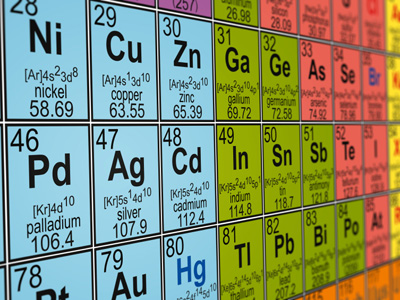
Ask the AI Tutor
Need help with Chemistry - The Periodic Table (AQA)? Ask our AI Tutor!
AI Tutor - Lucy
Connecting with Tutor...
Please wait while we establish connection

The periodic table helps us to understand the elements and their chemical properties.
Chemistry - The Periodic Table (AQA)
Learn how the Periodic Table is organised, from groups and periods to trends in melting points and bonding across Period 3, supporting your GCSE Chemistry AQA revision.
1 .
Which of the following statements best describes the elements in a period?
The elements in a period have different chemical properties
The elements in a period have the same chemical properties
The elements in a period have similar chemical properties
The elements in a period are inert
As you pass along a period, each chemical reacts differently
2 .
Where do you find the transition metals?
The central block
Left and right hand side blocks
At the top
Near the bottom
The transition metals are found in the central block and one of the properties that makes them stand out is that they form coloured compounds
3 .
The periodic table was originally arranged in order of atomic mass. We now know that it is the electron arrangement that determines how the elements react. Which of the following is the correct description of how you work out the electron arrangement of the first 20 elements?
There can be up to 8 electrons in each energy level (shell)
There must be 8 electrons in every energy level (shell)
There is a maximum of 2 in the first energy level (shell) and up to 8 in the rest
You can have up to 4 in the first energy level (shell) and 8 in the others
Each energy level (shell) must be filled before going on to the next
4 .
The elements are arranged in groups and periods. What is a period on the table?
A vertical column
A horizontal row
A diagonal row
A block of columns
The end of a period is marked by the noble gases
5 .
Where do you find the metals and non-metals in the periodic table?
Metals on the right, non-metals on the left
Non-metals in the middle surrounded by the metals
Metals in the middle surrounded by the non-metals
Metals on the left, non-metals on the right
The dividing line is a zig-zag starting between boron and carbon, extending until it reaches the halogens. The elements immediately to the left of this line show some properties of metals and some properties of non-metals
6 .
Lithium is at the top of Group 1. It reacts with water to form lithium hydroxide and hydrogen. Rubidium is lower down the group, when it reacts with water it produces what?
Rubidium hydroxide and hydrogen
Rubidium sulfate and oxygen
Rubidium hydride and hydrogen
Rubidium carbonate and helium
When you know the chemical reactions of one member of a group, you know the reactions of the others. Knowing that little gem could save you a lot of revision time!
7 .
Which of the following is true about the elements in a group?
They all have different chemical properties
They all have the same chemical properties
They all have similar chemical properties
They are all unreactive
The difficulty here should have been choosing between the 'same' properties and 'similar' properties. The key difference is that there is a pattern in their reactivity - but you don't need to remember that for the exam!
8 .
Group 8 is sometimes numbered as group 0 or group 18. What are the elements of this periodic table group called and why are they unreactive?
Noble solids and they have 8 electrons in their outer energy level (shell)
Noble liqids and they have 8 electrons in their outer energy level (shell) except helium which has 2
Noble gases and they have a complete (full) outer energy level (shell)
Noble elements and they have an empty outer energy level (shell)
The noble gases are unreactive because having a full outer energy level (shell) is a stable arrangement
9 .
How are the elements of the periodic table arranged?
They are arranged in ascending order of atomic number
They are arranged in ascending order of atomic mass
They are arranged in descending order of atomic number
They are arranged in descending order of atomic mass
In general, the atomic mass also increases as the atomic number increases - but that isn't always the case
10 .
Why do elements of the same group have similar chemical properties?
They all have 1 electron in the outer energy level (shell)
They have different atomic masses
They have different numbers of electrons in the outer energy level (shell)
They all have the same number of electrons in the outer shell
Chemical reactions involve the electrons in the outer energy level (shell) so if two elements have the same number of electrons in the energy level (shell) they will react in similar ways
**Unlimited Quizzes Await You! 🚀**
Hey there, quiz champ! 🌟 You've already tackled today's free questions.
Ready for more?
Ready for more?
🔓 Unlock UNLIMITED Quizzes and challenge yourself every day. But that's
not all...
not all...
🔥 As a Subscriber you can join our thrilling "Daily Streak" against other
quizzers. Try to win a coveted spot on our Hall of Fame Page.
quizzers. Try to win a coveted spot on our Hall of Fame Page.
Don't miss out! Join us now and keep the fun rolling. 🎉
**Unlimited Quizzes Await You! 🚀**
Hey there, quiz champ! 🌟 You've already tackled today's free questions. Ready for more?
🔓 Unlock UNLIMITED Quizzes and challenge yourself every day. But that's not all...
🔥 As a Subscriber you can join our thrilling "Daily Streak" against other quizzers. Try to win a coveted spot on our Hall of Fame Page.
Don't miss out! Join us now and keep the fun rolling. 🎉






